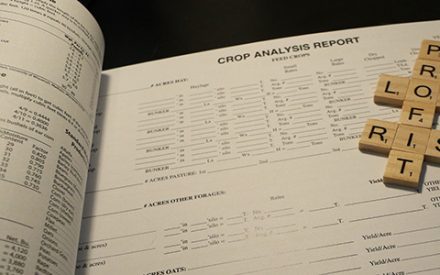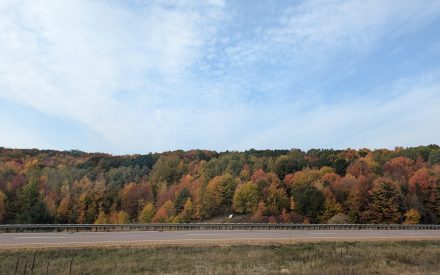Video Summary
In this video, Jerry Clark, regional crops educator, UW–Madison Extension, provides an update on malting barley research conducted in northwestern Wisconsin. The presentation covers variety trials, nitrogen and fungicide management, and quality testing for malting barley to meet craft brewing standards.
Jerry discusses the importance of selecting the right variety, managing nitrogen to balance yield and protein levels, and applying fungicides to control Fusarium head blight and maintain grain quality. He also shares results from sulfur and potassium trials, highlighting the economic and agronomic considerations for producing high-quality malting barley in Wisconsin.Resources
- Malting Barley Production, UW–Madison Extension Emerging Crops
Transcript
0:05
All right.
0:05
We’re going to talk about some of the malting work, malting barley research that we’ve done here in northwestern Wisconsin over the last several years.
0:15
We’ve had some interest from the craft brewing industry to see if we can grow good quality barley here in northwestern Wisconsin.
0:23
And there was a local ingredient need for some of that craft brewing industry and a number of the craft Brewers we’ve seen increase over the last 20 years seeing that that industry has kind of peaked couple years ago.
0:38
But there’s still quite a few out there that are interested in that, in that industry.
0:42
So what we’ve looked at over the last several years has been variety selection, what kind of varieties do perform well here in Wisconsin.
0:50
Some of these might be more experimental, some are some older varieties that we’ve had around for a while.
0:56
But then we’ve also looked at nitrogen and fungicide application rates and also did a small potassium and sulfur study kind of following up on what Scott was doing.
1:07
And our goal I guess is to introduce perhaps winter barley or even spring barley into that that crop rotation.
1:14
So what we’re going to focus on more today is the spring barley side of it as we’re moving along.
1:19
But we do have working with the University of Minnesota quite a bit of of information on some of the winter barley varieties as well.
1:27
So our variety trials, like any variety trial, we get these varieties through various sources depending on the year.
1:37
Some we get experimental like I said from the University of Minnesota, perhaps Cornell might send us one.
1:43
We also look at some of those from Washington State or Oregon that have breeding programs.
1:50
So like any variety trial, a lot of that final farm profitability or return per acre is really driven by the variety selection.
2:03
So again, Kewaunee being somewhat of an older variety still performs well.
2:08
But then if you see some of these S2M products, those are through the University of Minnesota, there’s some more experimentals out there.
2:17
And again, as we always try to make sure people have the right information, these trials are more locally driven by us here in the northwestern part of the state for growers to think about.
2:34
And OK, why is variety selection, some of the what craft Brewers might be looking for also the management part of it.
2:44
So when we look at the quality side of it, there’s, there’s quite a few different parameters that we look at in terms of what’s the quality of that grain.
2:52
And so some of the clarity, the protein is a big one in terms of not getting too much protein into that kernel of barley.
3:01
So we’d like to see that under 13.5.
3:04
Actually, we’d like to see it around 12 is, is more what the industry is really looking for, the word protein.
3:11
And again, some of these other tests that they do for the barley, the USDA Cereal Crops Research Unit does provide that type of testing.
3:21
And again, for those of us in the research side, we’re able to send that down there and get that done for little or no cost.
3:27
Again, if you’re a barley producer need to have that quality measured, there is a small fee that goes along with it.
3:34
But again, there’s a method of analysis for Barley malt and it has a criteria sheet, a full criteria sheet of what you need to meet for some of those specs.
3:43
So this is kind of what that spec sheet looks like from a quality standpoint.
3:48
So you can see that on the barley side, we were a little bit too high in 2023, good growing season for the most part, trying to not fertilize with nitrogen fertilizer and keep that barley protein level down.
4:05
But as you go along this column here with barley protein, you can see some of them definitely got a little bit too high, probably not going to make that grade for quality protein, quality barley.
4:17
So all of these parameters come with that test and then they do a ranking over here as far as how they rank within the samples that were sent in.
4:25
But they also compare you kind of to an industry standard.
4:28
So you get an idea of where your quality lands in terms of being able to market that to a craft Brewer.
4:37
One of the other studies that we’ve tried to do is with a fungicide application study.
4:41
We know Fusarium head blight is the biggest challenge that we have in a lot of our small grains.
4:47
So it’s no different than barley
4:49
And in whether it’s winter barley or spring barley, winter barley, we tend to not get quite as few quite as much infection as that tends to head out earlier in the year and maybe avoid some of that more humid weather that we get in June.
5:06
So we looked at what is needed from a fungicide application side of things.
5:11
And there again, that effect can be in a little smaller kernels if you do get that infection.
5:17
The mycotoxins we’re all pretty familiar with when Don shows up, we need less than one part per million Don in those samples from a quality standpoint.
5:26
And then if you’re a beer snob out there, you get uncontrollable foam and then it’s discolored.
5:32
So again, if Fusarium tends to show up and you’re a craft Brewer or doing some home brew and you’re having these issues, odds are some of that barley might have a Don infection to it.
5:43
So again, with Fusarium control, again looking at do we need 2 applications?
5:49
Can we get by with one?
5:50
How does that work?
5:51
Kind of the standard is get it early on that flag leaf that protects the yield and then the flowering part protects the grain from a quality standpoint.
6:01
So again, needing to scout and manage when we look into finding the head scab fungus out there.
6:07
So we did this fungicide study a few years ago in a couple of counties here in Chippewa and then again in Buffalo County.
6:13
But what I want to draw your attention to is kind of this variety Pinnacle.
6:17
Again, we’re going to see some differences with varieties, but you can see here that without a treatment, no treatment at all.
6:23
We definitely had a lower yield across the board once we applied either at just the leaf diseases.
6:31
So again, just a protection at the flag leaf versus some of those that are a combination at heading.
6:40
So we had Prossaro, we also had Mirvis Ace kind of mixed in depending on what we were using with the Approach.
6:47
And so these kinds of shows that that protection is needed out there specifically even just at least that one at the flag leaf does protect that yield.
7:00
But then when we look at the quality side of it, we can see that some of these it definitely drops if we can keep the, the the second application again at anthesis, we also did a potassium and sulfur application study.
7:15
We’ve been running this the last couple of years, kind of like Scott’s approach with sulfur.
7:21
We really didn’t see a big difference with sulfur.
7:23
Again, we’ve got some zero rates, but we also combined it with some potassium rates as well.
7:29
So we put 20 lbs of of sulfur out there and then change the potassium rate as we went along.
7:38
These were basically optimum fields.
7:42
They were not in the in the higher excessively high range for the potassium.
7:48
And so we kind of got a shotgun approach here.
7:51
There was a little effect on yield, but it really wasn’t related to much application.
7:55
So we got just as good of yields with the 0 application of K and sulphur.
8:00
Again, that could have been driven by the fact we were at an optimum soil test level.
8:08
We tried to run the quality tests with 2024 barley, but again like we needed to harvest ahead of some weather and when we had some crew available and probably harvested a little too early and that affected our our condition of the grain and therefore we did not get quality data from 2024.
8:30
Moving on to our nitrogen application study, again looking at it from again this nitrate and groundwater issue.
8:37
And so we looked at an application range anywhere from 15 to 70 lbs.
8:42
That’s kind of what the university looks at from UW.
8:45
That’s what’s in A2809 in terms of that’s what we can apply from an application recommendation.
8:53
Can we apply lower rates again, still get the yield, lower the quality of the lower the protein level to get that quality grain and then bottom line move it into farm profitability.
9:06
So the quality versus quantity that’s your nitrogen challenge.
9:10
You want obviously to get a yield out there.
9:12
But if you’re going to sell this for a hit those quality parameters, we got to have that protein below again 13 hopefully 12% is ideal where it goes that’s going to drive your kernel and plumpness and size of those kernels as we mentioned earlier and then the nitrogen impacts those protein levels directly.
9:32
It’s going to affect the head on your beers.
9:35
So again, if too high of a protein, you don’t get a good head on the beer.
9:39
And again, those of us that like beer and like a good head on our beer, if it gets that flat look to it, odds are that protein is probably a little bit too high.
9:49
So nitrogen can increase the yields.
9:51
So we want to keep that protein range somewhere between 9 1/2 to 12 1/2.
9:55
Again, USDA looks at it at 13 1/2, but the industry is going to push it towards under 13.
10:01
So that’s the challenge is get good yields without high protein.
10:06
So just throw up a few graphs here based on Chippewa County.
10:11
Again, these were depends on the the year we could get our hands on certain varieties.
10:17
Full Pint is a little shorter variety out of Oregon and you could see that year we used typically used anywhere from zero to 90 units of nitrogen on these replicated plots really no different that year.
10:32
We did see a little bit of difference with a couple with the varieties we tested in 2019 and then in 2018 kind of had that similar result where we saw an increase in in the yield as we bumped up.
10:46
But typically that higher rate pushing 90 lbs of nitrogen really didn’t result in that higher yield.
10:55
So in the end, what’s the bottom line in terms of this economic return?
11:00
Only one of the years that we tested did we really see that high rate be the one that gave us the best return on our on our acre.
11:08
And so that was in Buffalo County in in 2020.
11:13
Other years we landed somewhere between 30 and 60 lbs.
11:16
We know we need some nitrogen.
11:18
Do we need as much as 90?
11:20
Probably not.
11:21
I should back up.
11:22
Buffalo was more of a heavier soil, a more silt loam type soil.
11:26
Chippewa was an unirrigated sand and so that’s where you’ll see some of the differences here.
11:32
But for the most part in the in the six site years that we did, only one year did that high rate actually return us the most investment.
11:42
So in summary on this section, we have a minimum of probably 30 lbs per acre of nitrogen that we need to statistically maybe increase yield without and still keep quality in check.
11:55
The response is obviously dependent on location, variety, soil type.
11:58
We saw that in in our results there.
12:01
And then the nitrogen application rate provided those highest returns.
12:05
We didn’t see it really that much in that £90 rate.
12:08
And then again that fungicide application for protection is definitely needed at heading in terms of quality, but also the flag leaf in terms of yield.
12:17
So that recommendation of those two applications seem to come through in our small trials here in these two counties.
12:25
We do some extension outreach.
12:27
We got some websites our Chippewa County website.
12:29
We’ve also had this work published in the Journal of the National Association of County Agricultural Agents.
12:36
So if you’re interested in reading in depth more about what we did which resulted in these that provided these results, that’s available as well.
12:47
We are working with the University of Minnesota again on a winter barley trial.
12:50
I think a colleague of mine will full wider down in Dane and Dodge County is also doing some winter barley work.
12:57
So you might hear more of that as we continue with the Badger Crop Connect throughout some of the future episodes.
13:06
So I just want to provide some acknowledgements to the Buffalo County Barley Society.
13:10
They’ve provided a lot of the equipment and some of the support for this work.
13:15
Rahr Malting, the American Malting Barley Association, and USDA through the Cereal Crops Unit has provided some help on this.
13:23
So I’m going to wrap that up and as we kind of push towards the end, I’m going to stop sharing.
13:31
If there’s any questions, you can throw them in the chat.
13:33
Otherwise, send me an e-mail, should be there.
13:36
I can share that in the chat as well.
Badger Crop Connect
Timely Crop Updates for Wisconsin
Second and fourth Thursdays 12:30 – 1:30 p.m.
Live via Zoom

 ▶ Fall 2025 Financial Assistance for Producers
▶ Fall 2025 Financial Assistance for Producers ▶ Fall 2025 Ag Policy Update
▶ Fall 2025 Ag Policy Update ▶ Fall 2025 Corn and Soybean Market Outlook
▶ Fall 2025 Corn and Soybean Market Outlook ▶ November 6 Ag Weather Outlook for Wisconsin
▶ November 6 Ag Weather Outlook for Wisconsin


